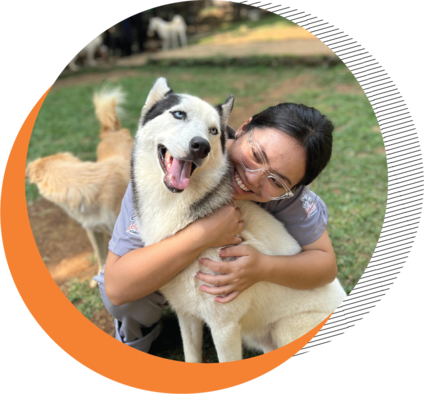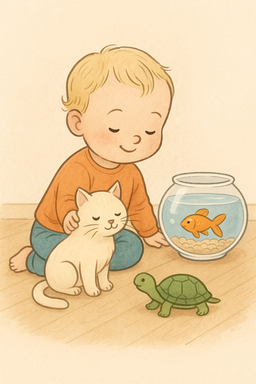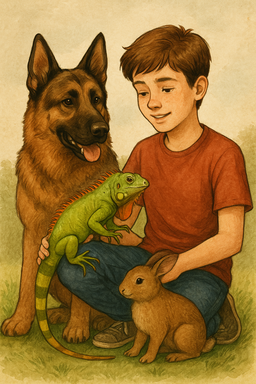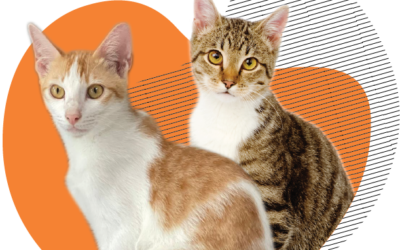
Pets Suitable for Children, According to Age!
Find the right pet for your child based on their age. From fish to dogs, check out our child-friendly pet recommendations here!
By: Drh. Mikeu Paujiah, Dipl. Montessori
Choosing a pet for your child isn’t just about picking the cutest one. Every animal has its own personality and specific care needs. Likewise, every child has a different level of maturity and ability to care for pets, depending on their age and emotional readiness.
So, if you want to introduce your child to a pet, first get to know the types of animals most suitable for each age group. That way, the experience of having a pet can be joyful—not a burden.

Toddler Age (1–4 years): Focus on Safe Interaction
At this age, children are still learning to control their emotions and motor skills. They tend to be impulsive and haven’t yet learned boundaries.
Recommended pets:
-
Fish (such as guppies or bettas)
-
Small turtles
-
Rabbits (with close supervision)
Note:
Pets at this stage are more for observation than for frequent touching. Parents play a 100% dominant role.

Preschool – Early Elementary (5–7 years): A Great Time to Learn Responsibility
Children at this age can begin to take on small tasks like feeding or cleaning food containers.
Recommended pets:
- Rabbits
- Hamsters
- Tame Cats
- Gold Fish
Tips :
Choose pets that are non-aggressive and easy to care for. Involve the child lightly in the daily pet care routine.

Elementary – Pre-Teen (8–11 years): Becoming Independent and More Empathetic
Children in this age group are usually more patient and better understand animal needs.
Recommended pets:
- Small dog breeds (like Pomeranians or Beagles)
- Cats
- Budgies or lovebirds
Note:
They can start learning to schedule feeding or clean cages with light supervision.

Teenagers (12 years and older): Ready for Bigger Responsibilities
Children at this age are generally able to care for pets more independently, even taking full responsibility.
Recommended pets:
- Medium to large dog breeds
- Any breed of cat
- Reptiles (with proper education and understanding)
- Adopted animals from shelters
Suggestion:
Encourage your teen to be involved in the adoption decision, from researching to understanding care costs.
Important Notes Before Choosing a Pet for Your Child
Before adopting a pet, consider the following:
- The animal’s lifespan (don’t choose just because it’s cute)
- Your family’s time and financial capacity
- Are there any allergies at home?
- Is every family member ready?
Don’t Choose Randomly. Choose the One That Clicks with Your Heart and Fits Your Home!
Choosing the right pet for your child is not just about age—it’s about family readiness too. The right pet can become a learning companion, a furry friend, and a responsibility trainer.
Once you know what pet fits best, don’t forget to teach your child how to treat animals kindly. And remember, animals have the right to be loved and cared for their entire lives.
Reference
Editorial, P. (2019, March 18). These are the best pets for kids at each age. PetMD. https://www.petmd.com/dog/pet-lover/these-are-best-pets-kids-each-age?
(N.d.). WebMD. Retrieved April 9, 2025, from https://www.webmd.com/pets/best-pets-for-kids
Related Post
STRAY ANIMALS AND THEIR ROLES IN PUBLIC HEALTH
STRAY ANIMALS AND THEIR ROLES IN PUBLIC HEALTH Stray animals have always been living with humans for a long time. It is known that whenever there are human populations, stray populations will follow; be it incidental or humans do affect strays to come and live with...
Learn about the five categories used in animal welfare assessment.
Learn about the five categories used in animal welfare assessment. For the first time developed in the 1950s, the Five Freedoms or Five Principles of Animal Welfare (Five Freedoms) have served as a global standard for animal welfare for many years. By: Drh.Mikeu...
Dog is NOT A LIVESTOCK, it’s a Beloved Pet
Dog is NOT A LIVESTOCK, it’s a Beloved Pet Dogs have the closest bond with people. One of the reasons why is because of its outstanding intelligence compared to other animals, so people can train it to help them. Dog is widely known as the most faithful people’s best...
WHAT HAPPENS WHEN A DOG IS CHAINED ALL THE TIME
What Happens When A Dog Is Chained All The Time Chain your dog all the time is quite endangering for its physical and mental health. This will disrupt its psychology and once being unleashed, it will become very aggressive and will try to run away from its owner. The...
Animal’s Level and Response to Traumatic Events
Animal’s Level and Response to Traumatic Events Not only humans, but animals also can experience traumatic events in their life. On a certain level, animals can cope with this. But on a higher level, these traumatic events can cause disturbance to their lives, and can...
Cat Lifestyle Spectrum
Gambaran Gaya Kehidupan Kucing International Cat Care’s (iCatCare’s) shares 4 cat lifestyle spectrums in the world. These lifestyles affect cats’ comfort when they interact with humans. Not every cat we can easily touch, because cats also have fear, anxiety and...





